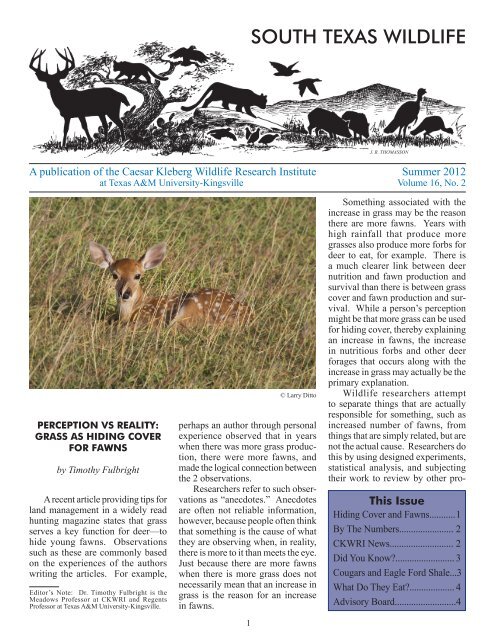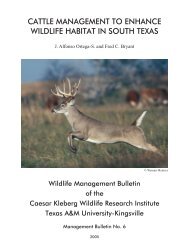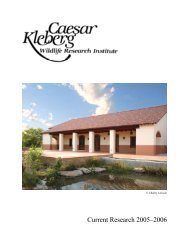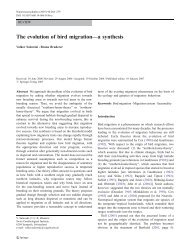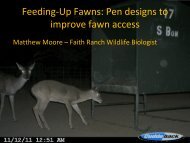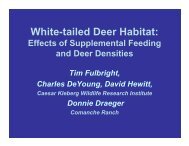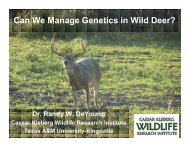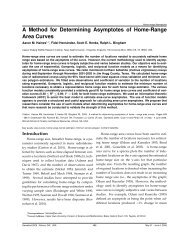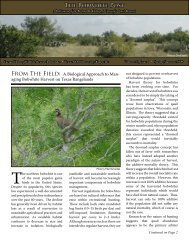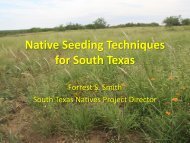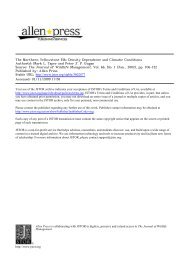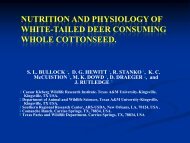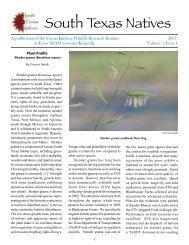south texas wildlife - Caesar Kleberg Wildlife Research Institute ...
south texas wildlife - Caesar Kleberg Wildlife Research Institute ...
south texas wildlife - Caesar Kleberg Wildlife Research Institute ...
Create successful ePaper yourself
Turn your PDF publications into a flip-book with our unique Google optimized e-Paper software.
SOUTH TEXAS WILDLIFE<br />
J. R. THOMASSON<br />
A publication of the <strong>Caesar</strong> <strong>Kleberg</strong> <strong>Wildlife</strong> <strong>Research</strong> <strong>Institute</strong> Summer 2012<br />
at Texas A&M University-Kingsville Volume 16, No. 2<br />
PERCEPTION VS REALITY:<br />
GRASS AS HIDING COVER<br />
FOR FAWNS<br />
by Timothy Fulbright<br />
A recent article providing tips for<br />
land management in a widely read<br />
hunting magazine states that grass<br />
serves a key function for deer—to<br />
hide young fawns. Observations<br />
such as these are commonly based<br />
on the experiences of the authors<br />
writing the articles. For example,<br />
Editor’s Note: Dr. Timothy Fulbright is the<br />
Meadows Professor at CKWRI and Regents<br />
Professor at Texas A&M University-Kingsville.<br />
perhaps an author through personal<br />
experience observed that in years<br />
when there was more grass production,<br />
there were more fawns, and<br />
made the logical connection between<br />
the 2 observations.<br />
<strong>Research</strong>ers refer to such observations<br />
as “anecdotes.” Anecdotes<br />
are often not reliable information,<br />
however, because people often think<br />
that something is the cause of what<br />
they are observing when, in reality,<br />
there is more to it than meets the eye.<br />
Just because there are more fawns<br />
when there is more grass does not<br />
necessarily mean that an increase in<br />
grass is the reason for an increase<br />
in fawns.<br />
1<br />
© Larry Ditto<br />
Something associated with the<br />
increase in grass may be the reason<br />
there are more fawns. Years with<br />
high rainfall that produce more<br />
grasses also produce more forbs for<br />
deer to eat, for example. There is<br />
a much clearer link between deer<br />
nutrition and fawn production and<br />
survival than there is between grass<br />
cover and fawn production and survival.<br />
While a person’s perception<br />
might be that more grass can be used<br />
for hiding cover, thereby explaining<br />
an increase in fawns, the increase<br />
in nutritious forbs and other deer<br />
forages that occurs along with the<br />
increase in grass may actually be the<br />
primary explanation.<br />
<strong>Wildlife</strong> researchers attempt<br />
to separate things that are actually<br />
responsible for something, such as<br />
increased number of fawns, from<br />
things that are simply related, but are<br />
not the actual cause. <strong>Research</strong>ers do<br />
this by using designed experiments,<br />
statistical analysis, and subjecting<br />
their work to review by other pro-<br />
This Issue<br />
Hiding Cover and Fawns........... 1<br />
By The Numbers....................... 2<br />
CKWRI News........................... 2<br />
Did You Know......................... 3<br />
Cougars and Eagle Ford Shale... 3<br />
What Do They Eat................... 4<br />
Advisory Board..........................4
By The Numbers<br />
4 number of toes on the front foot of a nine-banded armadillo<br />
(A Field Guide to Mammals of North America North of Mexico, F.A. Reid)<br />
40–60 incubation period in number of days for eggs of the Texas<br />
banded gecko (Field Guide to Texas Reptiles and Amphibians, R.D. Bartlett and<br />
P.P. Bartlett)<br />
484 estimated number in millions of dollars spent by deer<br />
hunters to access private lands in 2006 (USFWS)<br />
© Timothy Fulbright<br />
White-tailed deer fawns in South Texas<br />
select bed sites with thick grass cover<br />
that often includes a shrub.<br />
fessionals. As a result, the scientific<br />
literature is a more reliable source<br />
of information to base management<br />
decisions than articles found in nontechnical<br />
magazines.<br />
I recently read a dozen articles in<br />
scientific journals published between<br />
1979 and 2011 by researchers examining<br />
where white-tailed deer fawns<br />
chose to bed down. These studies<br />
were conducted in a variety of locations<br />
ranging from the grasslands of<br />
North Dakota to the forests of Michigan<br />
and to the brushlands of South<br />
Texas. One thing that the results<br />
of all these studies had in common<br />
is that fawns usually bed down in<br />
places with thick cover. The type of<br />
plants that compose the cover where<br />
fawns bed down is not as important<br />
as is the thickness of the vegetation.<br />
In grasslands, fawns often bed down<br />
in dense, tall grasses and forbs; in<br />
savannahs and shrublands, they<br />
often bed down beside shrubs.<br />
<strong>Wildlife</strong> managers reading magazines<br />
that talk about the importance<br />
of grass for fawning cover might get<br />
the idea that clearing woody vegetation<br />
and planting grasses are good<br />
management practices for whitetailed<br />
deer. In most of the range<br />
of white-tailed deer, management<br />
practices such as these can harm<br />
rather than benefit deer.<br />
In addition, the relative importance<br />
of “fawning cover” to help<br />
fawns avoid being seen by predators<br />
is questionable. No research to date<br />
has shown that more cover results in<br />
fewer fawns being seen and eaten by<br />
predators. Coyotes, for example,<br />
hunt their prey by hearing and smell<br />
as well as sight. One thing fawns<br />
may do when they are looking for<br />
a place to bed down is to find areas<br />
where it is harder for predators to<br />
smell them.<br />
Several deer researchers have<br />
suggested than fawning cover is<br />
more important for shade than it is<br />
for predator avoidance. Bedding<br />
down in the shade under a bush<br />
during midday in July to avoid<br />
excessive heat loads definitely<br />
makes sense.<br />
The bottom line is this: be<br />
careful about basing management<br />
decisions on people’s perceptions.<br />
Management decisions are best<br />
made if they are supported by<br />
research that has been subjected to<br />
rigorous peer review—then your<br />
<strong>wildlife</strong> management decisions will<br />
more likely be based on reality. ~<br />
CKWRI NEWS<br />
Karen Hixon Honored*<br />
Karen Hixon, spouse of<br />
CKWRI’s advisory board member<br />
Tim Hixon, was recognized for her<br />
lifetime of service to <strong>wildlife</strong> conservation<br />
by the Rotary Club of Corpus<br />
Christi and was presented with the<br />
Harvey Weil Sportsman Conservationist<br />
of the Year Award during a<br />
dinner on Saturday, April 28, 2012,<br />
at the Rob and Bessie Welder <strong>Wildlife</strong><br />
Foundation in Sinton, Texas.<br />
Harvey Weil was a longtime<br />
South Texas sportsman, attorney,<br />
conservationist, and Rotarian who<br />
dedicated his life to the preservation<br />
of nature and sportsmanship. To<br />
perpetuate Harvey’s legacy, a distinguished<br />
individual is chosen annually<br />
by the Rotary Club of Corpus<br />
Christi for this prestigious award.<br />
Karen’s background includes<br />
being appointed to the Texas Parks<br />
and <strong>Wildlife</strong> Commission in 2007,<br />
and she continues to serve in that<br />
role today. She also serves on the<br />
Board of Trustees of the Peregrine<br />
Fund, on the Texas Advisory Board<br />
for Trust for Public Land, and on the<br />
Advisory Board for Mitchell Lake<br />
Audubon Center in San Antonio,<br />
Texas. In addition, Karen has served<br />
on the Texas Parks and <strong>Wildlife</strong><br />
Foundation and on the Board of the<br />
Texas Nature Conservancy.<br />
Karen Hixon being presented with the<br />
Harvey Weil Sportsman Conservationist<br />
of the Year Award by Richard Leshin<br />
(left) and Mo Moorhead, sponsored by<br />
the Rotary Club of Corpus Christi.<br />
* Material from a press release by Lysa Chapman,<br />
Rotary Club of Corpus Christi.<br />
2
CKWRI congratulates Karen for<br />
her conservation service and welldeserved<br />
recognition by the Rotary<br />
Club of Corpus Christi. ~<br />
EAGLE FORD SHALE AND<br />
COUGAR POPULATIONS<br />
by Michael Tewes<br />
Former CKWRI Grad Student<br />
Receives Promotion<br />
One of CKWRI’s former<br />
graduate students Jennifer Mock<br />
Schaeffer was recently promoted<br />
to Government Affairs Director by<br />
the Association of Fish and <strong>Wildlife</strong><br />
Agencies (AFWA). Schaeffer will<br />
oversee and direct the legislative<br />
work of AFWA before the U.S. Congress,<br />
and the public policy work of<br />
AFWA before the federal Executive<br />
Branch agencies.<br />
Since joining AFWA in May<br />
2002, Jennifer has served as the<br />
Multistate Conservation Grant Program<br />
Coordinator<br />
and<br />
most recently<br />
as AFWA’s<br />
Agriculture<br />
Conservation<br />
Policy Analyst<br />
(Farm<br />
© Laura MacLean<br />
Jennifer Mock Schaeffer,<br />
former graduate<br />
student of CKWRI at<br />
TAMUK, was recently<br />
promoted to Government<br />
Affairs Director<br />
by the Association<br />
of Fish and <strong>Wildlife</strong><br />
Agencies.<br />
Bill). She also<br />
has provided<br />
staff support<br />
for AFWA’s<br />
Agricultural<br />
Conservation<br />
Committee<br />
and its<br />
11 working<br />
groups.<br />
Jennifer received a Bachelor of<br />
Science degree in Agriculture with<br />
a major in Range and <strong>Wildlife</strong> Management<br />
and a minor in Biology at<br />
Texas A&M University-Kingsville.<br />
She also received her Master of<br />
Science degree at Texas A&M<br />
University-Kingsville in Range and<br />
<strong>Wildlife</strong> Management, working with<br />
Dr. Michael Tewes on wild cats. ~<br />
Consider giving a tax-deductible<br />
donation to CKWRI<br />
How will cougars fare in South<br />
Texas Breeding populations of<br />
cougars presently occur in South<br />
Texas and the Trans-Pecos region<br />
of western Texas. Previous research<br />
has suggested that the South Texas<br />
cougar population is relatively small<br />
and isolated.<br />
The Eagle Ford Shale development<br />
involves an increase in human<br />
activity affecting areas that previously<br />
were relatively undisturbed.<br />
Because the shale play overlaps<br />
some of the best cougar habitat in<br />
South Texas, this development may<br />
impact this wild cat.<br />
The basis for this emerges from<br />
our research at the CKWRI in which<br />
we identified possible vulnerability<br />
of the South Texas cougar population.<br />
Small populations are often<br />
subjected to threats that are more<br />
easily absorbed by larger populations.<br />
Also, inbreeding is more<br />
likely in small populations.<br />
Our graduate student, Joe<br />
Holbrook, found low levels of<br />
genetic diversity in cougar samples<br />
from South Texas. During the past<br />
50 years in South Texas, genetic<br />
diversity has dropped by 9% and<br />
the “effective population size” of<br />
cougars has declined by 50%. The<br />
West Texas population has remained<br />
stable and is part of a larger population<br />
with habitat that extends into<br />
Mexico, New Mexico, and the<br />
Editor’s Note: Dr. Michael Tewes holds The Frank<br />
Daniel Yturria Endowed Chair for Wild Cat Studies<br />
at CKWRI and is a Regents Professor at Texas<br />
A&M University-Kingsville.<br />
Courtesy of Texas Parks and <strong>Wildlife</strong><br />
Rocky Mountains. Our genetic findings<br />
have confirmed that dispersal<br />
can occur periodically into and<br />
out of the South Texas population.<br />
However, the low number of successful<br />
dispersers may be too few to<br />
maintain genetic diversity.<br />
Another study that we have completed<br />
was led by Dr. John Young<br />
who used population modeling to<br />
assess the survival chances of the<br />
small cougar population in South<br />
Texas. Results suggested potential<br />
threats for cougar survival in this<br />
region. Variation in population<br />
reproduction, survival, and habitat<br />
conditions, including drought, which<br />
is frequent, could threaten cougar<br />
survival in South Texas.<br />
Our additional research at the<br />
CKWRI used an ecological niche<br />
computer model that showed most<br />
of the likely habitat for cougars in<br />
South Texas occurs in the western<br />
portion of the region. This habitat<br />
is not wide-spread or extensive, but<br />
generally localized, which is another<br />
reason for concern.<br />
Much of this habitat coincides<br />
with the historic and current assessments<br />
of cougar distribution and a<br />
belief that a population core occurs<br />
in the west-central area of South<br />
Did You Know<br />
The red-winged blackbird has a polygynous mating strategy (1 male<br />
to several females). (Handbook of Birds of the World, Volume 16)<br />
Ord’s kangaroo rats are considered nocturnal and are most active<br />
on dark, cloudy nights. (A Field Guide to Mammals of North America North of Mexico,<br />
F.A. Reid)<br />
3
Texas. These research findings on<br />
cougars in South Texas are coinciding<br />
with the unfolding development<br />
of the Eagle Ford Shale. The Eagle<br />
Ford Shale is a recently discovered<br />
hydrocarbon formation of significant<br />
importance because of its capability<br />
of producing more gas and oil than<br />
other shale deposits.<br />
Development of the Eagle Ford<br />
Shale represents a major transformation<br />
of the economic and rural<br />
environment in many parts of South<br />
Texas, where production from the<br />
vast oil and gas field has surpassed<br />
forecasts. In the past 2 years, there<br />
has been a sharp increase in the infrastructure<br />
and extraction activities<br />
associated with this petrochemical<br />
resource. The number of drilling<br />
permits for the Eagle Ford Shale<br />
increased from 33 in 2008 to 1,229<br />
in 2010.<br />
Actual development continues<br />
to exceed the predictions of rapid<br />
growth. The Eagle Ford Consortium<br />
estimated that the shale would<br />
produce 2.1 million barrels of oil in<br />
2010. Instead, the shale produced<br />
What Do They Eat<br />
Advisory Board<br />
The Advisory Board of the <strong>Caesar</strong> <strong>Kleberg</strong> <strong>Wildlife</strong> <strong>Research</strong> <strong>Institute</strong> provides<br />
leadership in all aspects of our work. We are indebted to them for their commitment<br />
to CKWRI and its mission.<br />
Gus T. Canales<br />
T. Dan Friedkin<br />
Henry R. Hamman<br />
(Chairman)<br />
George C. “Tim” Hixon<br />
Karen Hunke<br />
4.4 million in the first 11 months of<br />
that year. For 2011, production of<br />
8.7 million barrels of oil was forecasted.<br />
Almost 22 million barrels<br />
of oil were extracted in the January-<br />
November period of 2011. A prediction<br />
was not given for 2012.<br />
<strong>Wildlife</strong> biologists visiting the<br />
area where the Eagle Ford Shale<br />
overlaps the core of the cougar<br />
population are amazed at the rapid<br />
oil and gas development within the<br />
area. There is a major increase in<br />
the number of wells and related<br />
roads and pipelines. Truck traffic<br />
has greatly increased on many of<br />
these rural roads, and activities on<br />
previously undisturbed ranches have<br />
expanded tremendously.<br />
Northern cardinals forage on seeds, fruits, insects, and snails.<br />
(Handbook of Birds of the World, Volume 16)<br />
A. C. Jones, IV<br />
David Winfield Killam<br />
Tio <strong>Kleberg</strong><br />
C. Berdon Lawrence<br />
Kenneth E. Leonard<br />
James A. McAllen<br />
Barry Coates Roberts<br />
Stuart W. Stedman<br />
Buddy Temple<br />
Ben F. Vaughan, III<br />
Bryan Wagner<br />
Charles A. Williams<br />
Some industry observers suggest<br />
this development may continue for<br />
15 to 20 years. This activity will be<br />
a major economic engine for many<br />
counties in South Texas, benefitting<br />
numerous small communities and<br />
extensive rural areas. However,<br />
the concern for cougars is that the<br />
western portion of the Eagle Ford<br />
Shale overlaps much of the historical<br />
and current core area of cougars in<br />
South Texas.<br />
In summary, the exploration in<br />
the Eagle Ford Shale likely poses<br />
additional risk to the vulnerable<br />
cougar population in South Texas—<br />
a risk that needs to be measured.<br />
There is an urgent need for information<br />
to assess the status of cougars<br />
in South Texas, as well as cougar<br />
responses to the Eagle Ford Shale<br />
development. ~<br />
Franklin’s ground squirrels have an omnivorous diet consisting of<br />
seeds, plant material, small mammals, toads, birds, and insects.<br />
(A Field Guide to Mammals of North America North of Mexico, F.A. Reid)<br />
Visit our web page at<br />
http://www.ckwri.tamuk.edu<br />
<strong>Caesar</strong> <strong>Kleberg</strong> <strong>Wildlife</strong><br />
<strong>Research</strong> <strong>Institute</strong><br />
700 University Boulevard<br />
MSC 218<br />
Kingsville, Texas 78363-8202<br />
Editor: Alan Fedynich, Ph.D.<br />
SOUTH TEXAS WILDLIFE is printed on recycled paper<br />
4


